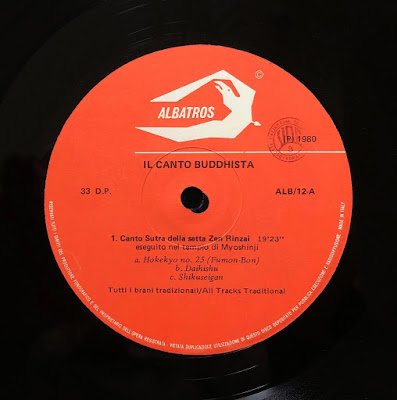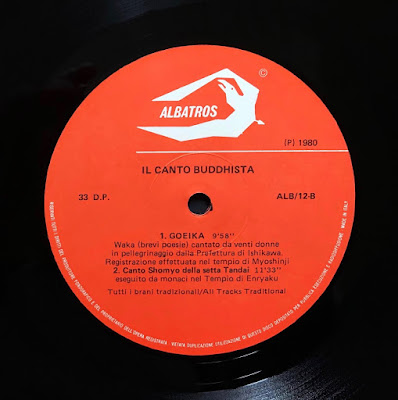Il Canto Buddhista / Buddhist Chant – Albatros ALB/12 – Recorded by Katsumasa Takasago in various temples in Kyoto, Japan, published 1980 (2 LP)
These deep inspired chants by groups of monks, priests, or pilgrims accompanied by traditional instruments were recorded during ceremonies and rituals in Kyoto, a historic center of worship for Japanese Buddhists. The performances, which draw on classic poems and sutras and highlight the specific musical characteristics of various Japanese Buddhist traditions, include invocations of the Buddha, purification chants, sung poetry, and prayers for world peace and prevention of disasters.
Ces chants profonds et inspirés de prêtres, de moines ou de pèlerins accompagnés d'instruments traditionnels ont été enregistrés lors de cérémonies et de rituels à Kyoto, un centre historique de culte bouddhiste japonais. Ces performances, qui ont pour thèmes des poèmes ou des soutras classiques, allant des invocations du Bouddha à des chants de purification, des poèmes chantés ou des prières pour la paix et la prévention de catastrophes dans le monde, mettent en évidence les caractéristiques musicales spécifiques de diverses traditions bouddhistes japonaises.
A – Three sutras chanted by Zen Rinzai monks at Myoshinji Temple.
Zen chants are an exercise in self-discipline, with Zen monks chanting while sitting in the zazen posture. The sound of kei metal singing bowls mark the beginning of each sutra with mokugyo percussion setting the tempo for the chanting.
Zen chants are an exercise in self-discipline, with Zen monks chanting while sitting in the zazen posture. The sound of kei metal singing bowls mark the beginning of each sutra with mokugyo percussion setting the tempo for the chanting.
B1 – Goeika chanting of waka short poems sung by 20 female pilgrims at Myoshinji Temple.
Goeika chanting of waka by pilgrims, accompanied by rin bells and small fusegane metal drum struck with a crystal hammer. The leader strikes a kei gong to mark the transition from one poem to the next.
Goeika chanting of waka by pilgrims, accompanied by rin bells and small fusegane metal drum struck with a crystal hammer. The leader strikes a kei gong to mark the transition from one poem to the next.
B2 – Shomyo chant by Tendai monks at Enryaku Temple.
Tendai pentatonic Shomyo chants by ten priests accompanied by rin bells, nyo cymbals and shakujo rattles. The ritual begins with a leader chanting the first few lines, after which the other priests join in.
C1 – Four sutras – Nembutsu invocations of Amida, the celestial Buddha, chanted by Jodo priests at Kurodani Temple.
Accompanied by kei gongs, mokugyo percussion, nyo-hachi cymbals, and clappers, the chant is like a slow stream of water.
C2 – Zen solo chants by priests at Myoshinji Temple
Zen roshis (venerable respected priests) may chant at any time of the day, accompanied by kei gongs and mokugyo percussion.
D – Morning chants by Shuken Yamabushi priests at Shogoin Palace.
The Shuken-shu, which dates back to the seventh century and combines elements of Buddhism, Confucianism and Shintoism, use horogai conch shells in their music.
*Condensed and paraphrased from the liner notes of Katsumasa Takasago.
The photographs below are from Shashin Voyageurs et Photographes au Japon: 1868-1912 by Frank Berzieri, Phebus, 2009; 2000 Years of Japanese Art by Yukio Yashiro and Peter Swann, Thames & Hudson, 1958; and Zen: Direct Pointing to Reality by Ann Bancroft, Thames & Hudson, 1987.
Former Hyogo Daibutsu (Great Buddha), Kobe, c.1890.
Melted down in 1944 for the war effort and since replaced.
Melted down in 1944 for the war effort and since replaced.
Japanese Buddhist monk, by Baron Raimund von Stillfried, c. 1880.
Please help me purchase important traditional records to pursue my global
curation project and share the best finds with you on this blog:










Teşekkürler...
ReplyDeleteI just downloaded this double LP and realised it's actually the same recordings as issued in 1963 on the well known US label Lyrichord (Zen, Goieka & Shomyo/Japanese Temple Music LLST 7116/7), which I bought some 50 years ago! I couldn't see any indication in the sleeve notes of this Albatros reissue noting this. Not really a criticism, just a point of information. I think, the mastering in this Albatros reissue is a bit clearer than on the original Lyrichord LP's, so thanks for uploading it.
ReplyDeleteIn addition to releasing heritage collections of Italian regional music, the Italian Albatros label has also reissued great recordings from labels like Lyrichord and Folkways that sound much better than the originals. I have already posted a number of their excellent reissues of traditional music from all continents.
Delete